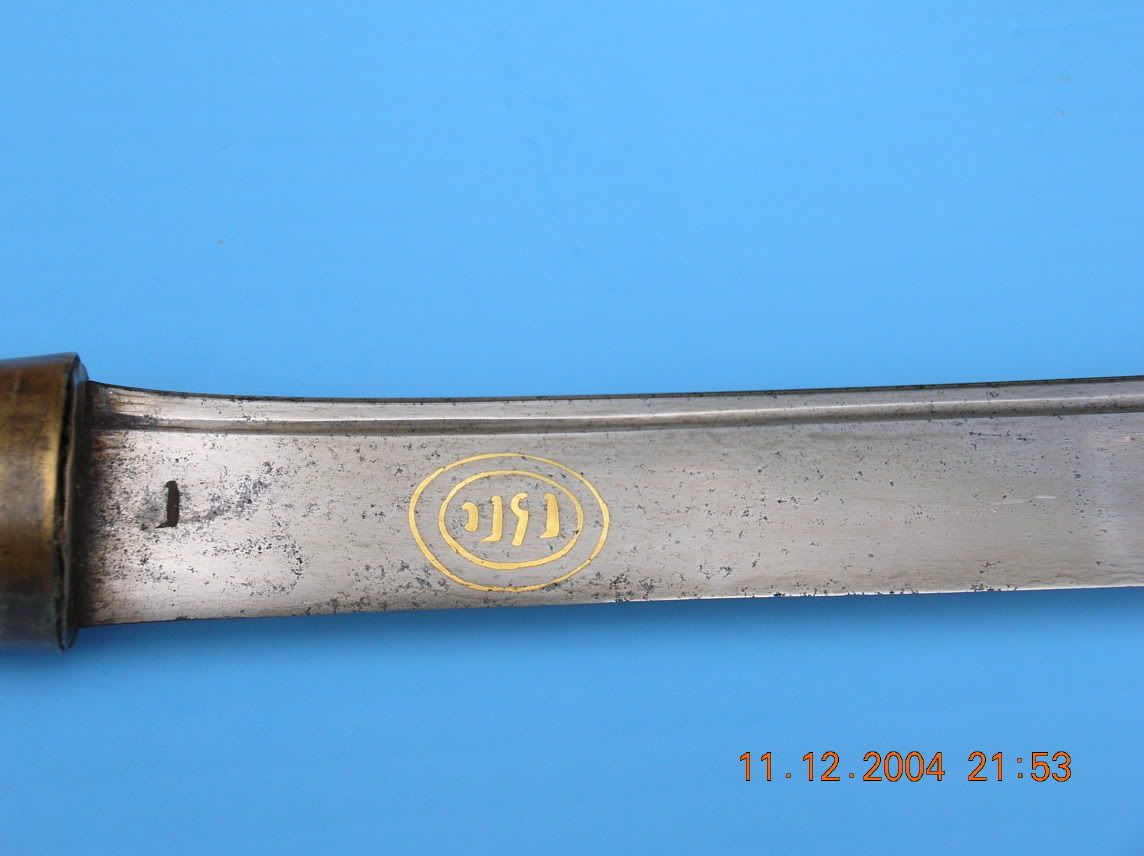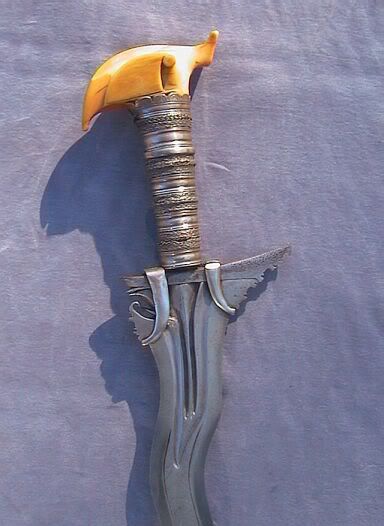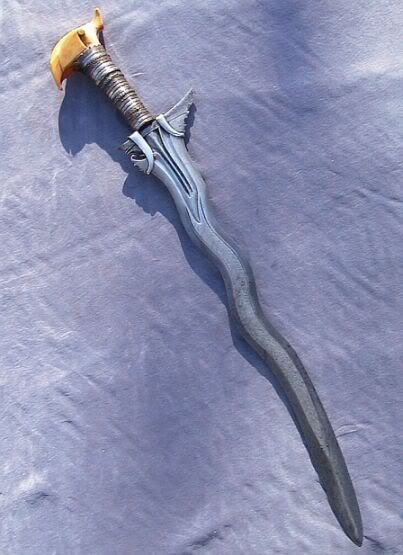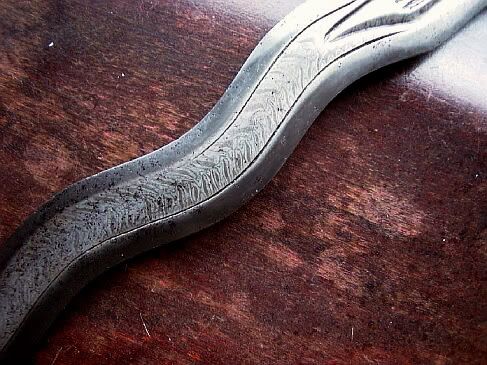
 |
|
|
#1 |
|
Member
Join Date: Jun 2006
Posts: 161
|
Why posting this? I was discussing kris etc. on another board and a person from Indonesia mentioned he'd never seen any. Here are two weapons which both came from the Philippines. The short one, a punang?, came back with my dad in 1945, and I think I got the long one, the kris, in Manila in 1973.
I'd like to know if southeast Asian edged weapons inlaid with various metals are unique to the Philippines, or what. The punang (dagger) has brass and copper inlaid into grooves in the blade. The kris has a serpant or dragon-like recessed shape, the "scales" of which are inlaid with a silver-colored metal. Thanks in advance! |
|
|
|
|
#2 |
|
Member
Join Date: Dec 2004
Posts: 987
|
Brass and copper inlay is fairly common in continental Southeast Asia, though not usually as elaborate as what you have on your kris. It is common to see a section along the spine that is inlaid with a brass or copper slug (sometimes both, see below), and inlaid writing is also fairly common. Elaborate decorative designs are more often incised or in koftgari, I think.
A dha with brass & copper slugs in the spine:  A dha with inlaid writing on the spine, and also koftgari:  This is the most beautiful inlay I have seen on a dha blade (this one belongs to John "RhysMichael"):  Here is an inlaid date on one of Andrew's: 
|
|
|
|
|
#3 |
|
Member
Join Date: Dec 2004
Location: Cincinnati, OH
Posts: 940
|
Nice work on the kris. It looks like a mid-20thC piece to me, but of a higher standartd than most from this period.
The knife is known as a gunong AFAIK. Sometimes called a punal, but if i am not mistaken that is a Spanish, and therefore less indiginous term. Nice work on that as well. 
|
|
|
|
|
#4 |
|
Member
Join Date: Jun 2006
Posts: 161
|
Thanks for taking the time to post the very interesting pictures. They answer the question so much better than just words.
|
|
|
|
|
#5 |
|
Member
Join Date: Dec 2004
Location: Cincinnati, OH
Posts: 940
|
You know, the more i look at the pics of the kris the more it looks like there just might be a really well fitted seperate gangya on it, in which case i might change my age assessment. Is it a seperate piece? I have one that for years i thought was one piece until i etched it one day and found the tight seem.

|
|
|
|
|
#6 |
|
Member
Join Date: Jun 2006
Posts: 161
|
No the steel blade seems to be all one piece. The serpent thing was carved into the basic blade. I don't see any way it could be a separate piece when I look at both ends of the serpent. The ends simply merge smoothly into the steel of the blade with no change in appearance.
Anyway, when I looked at it all under magnification, it sure looked antique to me. There are so many different metals and materials in it, the handle, etc, and they all look like they should, to me anyway, if antique. |
|
|
|
|
#7 |
|
Member
Join Date: Jun 2006
Location: Ubud, Bali, Indonesia
Posts: 16
|
This kris from the Philippines is quite different from its Indonesian counterparts. Of immediate note is that the blade maintains the same width the entire length of the blade. As the kris is predominately a stabbing weapon, that seems rather impractical and the unnecessary weight would add additional strain on the tang. Aesthetically, the handle almost appears ridiculous in concert with its blade, or way out of balance. Another noticeable difference is that there does not seem to be any pamor worked into the iron. A final observation is that the formation of the luk is not like the smooth flow seen in Indonesian kris, in fact the top of the curves almost appear to be pointed. .
This is the first I have seen a kris from the Philippines, so these are just my initial observations, and they are not intended to “knock” or criticize. Thanks for posting those photos! |
|
|
|
|
#8 |
|
Member
Join Date: Jun 2006
Posts: 161
|
I'm pretty sure that in the Philippines, the kris, at least of the type I posted, was used as a side-cutting or slashing weapon primarily. The blades are rather thick in the middle, and heavy, and have lots of momentum if they are swung. The US Army found this out to their dismay ca. 1900. It is pretty well documented that the Moros armed with these would swing them to strike the soldiers between the neck and shoulder, and many of those deep wounds were mortal. The Filipino, or Moro kris would not be too efficient for stabbing due to relatively blunt end, but the blade was sharpened all around so they could do that also.
|
|
|
|
|
#9 |
|
Member
Join Date: Dec 2004
Posts: 221
|
try stabbing with a rounded or pointed sharp moro kris straight or wavy, they are effective for cutting or thrusting...
|
|
|
|
|
#10 |
|
Member
Join Date: Dec 2004
Location: Cincinnati, OH
Posts: 940
|
Wayan, as has been pointeed out to you, kris from the Philippines, while related to the Indonesian keris, are quite a dfferent animal. I can assure you that in full on combat it is a far superior weapon to it's smaller stabbing cousin. Primarily a slashing and chopping weapon, it is generally razor sharp and can also stab as Mabagani points (no pun intended
 ) out. They are usually rather well balanced blades as well. In hand i think perhaps your thoughts on the proportions and weigh might change. ) out. They are usually rather well balanced blades as well. In hand i think perhaps your thoughts on the proportions and weigh might change.Cannonmn, it has been generally accepted that kris without a seperate gangya are usually post-1930s blades. There are, of course, exceptions to that. A 1930s blade would be cosidered antique by many, being over 70 years old. I'm still not convinced yet that yours is quite that old. The luks of the blade seem somewhat pointed, another indicator of a younger blade. Still it appears to be a well made blade, not something made for the export market. Are the bands on the sheathy aluminium? Your gunong appears to be missing it's guard. Still a nice example. I like the inlay. 
|
|
|
|
|
#11 |
|
Member
Join Date: Dec 2004
Location: Witness Protection Program
Posts: 1,730
|
cannonmn,
here's a kris similar to yours: http://cgi.ebay.com/ws/eBayISAPI.dll...MEWA%3AIT&rd=1 you didn't mentioned the size, but i bet the blade is around 27" no? wayan, think of the moro kris as an indo keris on some serious steroids and growth hormones 
|
|
|
|
|
#12 |
|
Member
Join Date: Jun 2006
Posts: 161
|
Yes the measurements of mine are same as Snyder's on Ebay (btw he is longtime acquaintence.) So mine is 27 in. tip to center of handle, and guard is 6.5 in. wide. You'd almost think his and mine were by the same maker? Thanks for finding another like mine.
The two whitish bands shown on the scabbard I have are actually masking tape put on in recent years to keep scabbard from falling apart. A very thin brass band remains alongside one of the tape windings. |
|
|
|
|
#13 |
|
Member
Join Date: Jun 2006
Location: Ubud, Bali, Indonesia
Posts: 16
|
Well, this is all interesting. I would like to see a kris from the Philippines without its hilt, in order to judge the size of the tang in relation to the blade.
Thinking of an Indonesian kris on “steroids or growth hormones” is not something I care to envision. In Indonesia, and particularly in Bali, the kris is regarded as pusaka, a revered work of the gifted Empu who wrought it, and its powers are not defined by drugs or hormones. In Indonesia, a kris is a work of art. Many Indonesians would say it is the ultimate work of art, and given the incredibly beautiful sarongs, or sheaths that have been made here, wrought with silver or gold, and adorned with Kalimantan diamonds, rubies and sapphires from India, combined with equally outrageous hilts, it’s fairly evident that the extent of admiration we have here in Indonesia for our kris pusaka transcends thinking of our kris as mere weapons. For a man in Indonesia, his kris is his soul, and a direct extension of his body. I can assure any reader of this forum that no serious Indonesian collector of kris would even pass a thought of including a kris such as this Philippine kris in their collection. A kris without perfect grace and elegance is merely a dead piece of iron. Last edited by Wayan; 24th June 2006 at 02:40 PM. |
|
|
|
|
#14 |
|
Member
Join Date: Jun 2006
Location: Ubud, Bali, Indonesia
Posts: 16
|
To illustrate my point, about Indonesian kris, or in this case, Balinese kris, as being works of art, I offer the two links below....(too large, and too much time to upload).
Both kris are late 18th, or early 19th century, and both are in their original sarongs as offered to me at the time I acquired them. The first kris is in its sarong kampung, or normal sarong. Not uncommonly, fine Balinese kris may have two, or even three various sarongs, (much like the men who own them) suitable for the occasion where kris bearing is essential. The second kris is of the same age, and seen in its sarong Pura, a more formal presentation, reflecting the caste, or stature of its Balinese owner. Their sarong aside, it is the blade, the kris itself, that merits discussion. While neither of these blades are masterpieces, each of them exhibit the fine and utterly balanced design that goes into all Indonesian Empu made kris. I think it is self evident, or at least I hope it is, that both kris blades are flawless in their execution and they present a timeless image of perfection, which is only highlighted by their brilliant nickel pamor. Understandably, I am of course biased in my opinions regarding Balinese made kris, which are in general more substantial than the kris made in Java, Sulawesi, or other parts of Indonesia. Aside from having our Empu and pande, directly descended from the Majapahit, only here in Bali does the restriction of human figures not apply to the arts, (as we are Hindu), thus the variety of our hilts is endless. http://www.sundream.com/~majapahit/images/kris17.jpg http://www.sundream.com/~majapahit/images/Kris31.jpg |
|
|
|
|
#15 | |||
|
Member
Join Date: Apr 2005
Posts: 3,255
|
Hello Wayan,
Welcome to the forum! Please be careful since keris/kris threads are somewhat notorious to get a little quarrelsome once in a while...   On this forum we follow the convention of distinguishing between the "kris" (aka keris sundang) from the southern Philippines (but also found across Borneo, Sumatra and the Malay Peninsula) and the "keris" (i.e. the more traditional styles mainly found in Malaya, Sumatra, Jawa and Bali/Lombok (also Borneo, southern Thailand, etc.). Quote:
Quote:
 Quote:
 I'd also stipulate that aesthetics are bound to differ from one ethnic/cultural group to another so we need to be careful with our own preferences. Among the different keris styles I also see quite large differences (i.e. Malay/Sumatran/Bugis keris vs. Jawa vs. Bali/Lombok, keris panjang and many other keris styles which may appear odd to outsiders!). |
|||
|
|
|
|
#16 | |
|
Vikingsword Staff
Join Date: Nov 2004
Posts: 6,339
|
Quote:
What nechesh meant by a separate piece was this area pictured below . 
|
|
|
|
|
|
#17 | |
|
Member
Join Date: Dec 2004
Location: Witness Protection Program
Posts: 1,730
|
oh boy! this looks like it's gonna be a long thread...
Quote:

|
|
|
|
|
|
#18 |
|
Member
Join Date: Dec 2004
Location: Cincinnati, OH
Posts: 940
|
Hi Wayan,
I would second Kai's cautious words here. It seems you don't really know enough about Moro kris to be passing such judgements. Pehaps you should spent some time with the search function of this forum and check out the level of skill and artistry that can be found in the Moro kris before making any further comments. My own personal tastes run more towards the Indonesian keris myself and i have a very strong affection for Bali blades in particular. But i also have 3 Moro blades in my collection which i quite enjoy and the quality of their workmanship is hardly inferior. Moro blades do tend to be far more functional and were used as actual weapons of war, unlike most Indo keris. But their owners also saw them as having a powerful mystical/magickal side. This is warrior magick. I wouldn't assign a better or worse title to it. I don't think you will get very far on this forum disrespecting or diminishing other peoples cultures. The Moro (and people who collect their weapons) take their kris very seriously. It is a powerful weapon both practically and spiritually, though perhaps not in the same complex and variant modes as the Indo keris. They don't use complex pamor patterns, but there is a beauty to the pure functional form of them. AS to your question about the tang, the Moro kris tang is rectangular, unlike the round Indo ones. The blade is also additionally secured by one or two stirrups called baca-baca. I can assure you there is NOTHING fragile about this construction and the tang is not likely to bend under the fiercest of combat situations. Very nice keris that you linked to. Neither, however, is "flawless in their execution". The hilt on the second one is exquisite though. Looks like recent work to me. BTW, you will also find figurative hilts from Java, Madura and Sumatra and the so-called "kingfisher" hilts from the penisula areas. 
|
|
|
|
|
#19 | |
|
Member
Join Date: Dec 2004
Location: Cincinnati, OH
Posts: 940
|
Quote:

|
|
|
|
|
|
#20 |
|
Vikingsword Staff
Join Date: Nov 2004
Posts: 6,339
|
This is posted so many times here that I'm going to save bandwidth and hot link it . Moro Kris :
   Oh and Spunjer , no way Man . 
|
|
|
|
|
#21 |
|
Member
Join Date: Jun 2006
Location: Ubud, Bali, Indonesia
Posts: 16
|
In response to Kai:
Why am I being told to “be careful” when discussing the kris of my homeland? And why is this said by someone who lives in Germany? Of course any discussion of kris can be charged. You should hear me argue with my Islamic brothers from Java! They actually think the kris was “invented” within Islam. They also think the same of batik, wayan kulit, topeng, and gamelon, just to mention a few. Silly boys...but when they come to Bali, they are quiet. Many thanks for the link to see one of these Philippine kris in the buff, so to speak. The tang on them appears to be rectangular, as opposed to circular. But, the tang, in relation to the blade, in width and length makes it impossible for me to envision this blade as an effective slashing weapon. The tang, on the example you linked seems to me to be way too small in relation to a wide, and clumsy blade to defy simple laws of physics. Unless the tang on that blade was forged again into an iron, or bronze hilt, I think simple physics....the stress on the tang, would render it rather useless as a slashing weapon. On this forum, you can follow whatever convention you desire in the discussion of kris. I have no problem with that. When I post about kris, I will make it very clear if my post is about a Balinese kris, a Javanese kris, a Bugis kris from Sulawesi...whatever. Regarding aesthetics, they are indeed personal, and I agree they vary greatly from one to another. If a participant on this forum is not allowed to offer their aesthetics, which are obviously open to discussion, and rejection by other forum members, then count me out of here, right now. My personal style is not to walk on egg shells, nor will I bow to anyone except my priests and my elders. I’m not looking for a fight, but I have not written anything here that deserves a caution. It’s also odd that you did not comment on either of the average Balinese kris I linked in my last post. I offered those photos only as an aesthetic comparison to the Philippine kris which I find to be clumsy, without grace, and without elegance. But hey! That’s only my opinion! |
|
|
|
|
#22 |
|
Member
Join Date: Dec 2004
Location: Italia
Posts: 1,243
|
Hey Rick, this is a VERY BEAUTY!!!!!!! WOOOW
   
|
|
|
|
|
#23 |
|
Member
Join Date: Jun 2006
Location: Ubud, Bali, Indonesia
Posts: 16
|
In reply to “Nechesh”
You write: “I don't think you will get very far on this forum disrespecting or diminishing other peoples (sic) cultures.” Where the hell did I do that? My comments ONLY addressed the blade, as originally posted and that is it! Who the hell are you to accuse me of “disrespecting or diminishing other peoples (sic) cultures.” I never do that, never have, and surely I don’t like being falsely accused of doing so. An apology is warranted, AND expected! |
|
|
|
|
#24 |
|
Vikingsword Staff
Join Date: Nov 2004
Posts: 6,339
|
Wayan , please read the posting rules found at the top of the discussion list .
We always aim to be polite and non confrontational here ; this is absolutely *not* a 'no holds barred' forum and decorum and politeness must be maintained . A cautionary word does not an insult make .  By the way I like very much this piece that you show : http://www.sundream.com/~majapahit/images/Kris31.jpg What god or raksassa does the ukiran represent ? Do they make blawong to fit Bali kerisses ; I ask because the one you show dwarfs the Jawa blawong it is in .  Rick |
|
|
|
|
#25 |
|
Member
Join Date: Dec 2004
Posts: 221
|
peoples of keris/kris cultures share common heritages in their weaopnry as well as in music, dress, language, religion, etc...so i will refrain from degrading opinions, we're like distant cousins so to speak
the keris and kris evolved differently around the Mindanao and Sulu Sultanates because their warriors continued fighting foreign invasion over three centuries being open about keris and kris is like a family gathering...bring on the food fight. lolz |
|
|
|
|
#26 |
|
Member
Join Date: Jun 2006
Location: Ubud, Bali, Indonesia
Posts: 16
|
And, as a follow up to “Nechesh” who wrote the following:
“The hilt on the second one is exquisite though. Looks like recent work to me. BTW, you will also find figurative hilts from Java, Madura and Sumatra and the so-called "kingfisher" hilts from the peninsula areas.” The hilt is not recent work, in fact that kris, hilt, sarong and all, has been in the family of a Balinese high priest for several generations. When you make generic comments like, “looks like recent work to me” is it not too much to ask that you provide specific reasons for your declaration? If you have some particular expertise, then isn’t it fair to document your comments? By figurative hilts, I refer to hilts that are clearly of human personage which is forbidden in Islam. Good luck finding a hilt from Java, Madura, or Sumatra carved as Bayu, Anak Raja, Wishnu....or just a simple half naked lady! |
|
|
|
|
#27 |
|
Member
Join Date: Jan 2005
Posts: 55
|
the agung is ringing....
|
|
|
|
|
#28 |
|
Member
Join Date: Dec 2004
Posts: 221
|
sundangs a shaking...
|
|
|
|
|
#29 |
|
Member
Join Date: Dec 2004
Location: Cincinnati, OH
Posts: 940
|
Sorry Wayan, but you'll get no apology from me. Perhaps disrespectful was too harsh a word, but your whole attitude in this matter is completely dismissive. This thread is about two MORO weapons, a kris and a gunong, yet you find it necessarry to post here about how superior the Balinese keris is to Moro Weapons. Well, firstly, it's apples and oranges. You can't really compare the two. But it is not the subject line of this thread anyway.
You actually DO show disrespect for a few of us "serious" collectors of Indonesian keris who DO include Moro kris in our collections. I can assure you i am a very serious collector and student. As i stated, my preference is firmly in the Indo camp, which is why i only have 3 Moro kris and about 3 dozen Indo keris. But please don't insult me by implying that i am not a "serious" collector because of this. You seem to know as little about physics as you do about Moro kris. You should probably skip the science and just look at the history. A Moro warrior armed with a kris was once considered the most fiercesome opponent of the U.S. Marine Corp. and there are many reports of soldiers nearly cleaved in two by a wound from a kris. So physics be damned i guess.  Bottom line is that you are hi-jacking this thread and turning it into a debate about the superiority the Bali keris. This thread should be about the weapons presented. If you use the search function you will no doubt find many threads on Indo keris and specifically Bali keris and i also encourage you to start new threads on these subjects. I will gladly join inn the discussion there and look forward to the occasion. I am sure that you have a lot to offer this forum. |
|
|
|
|
#30 | |
|
Member
Join Date: Dec 2004
Location: Cincinnati, OH
Posts: 940
|
Quote:
I meant no disrespect in my comment on the age of your Bali hilt. This quality of workmanship can STILL be found in Bali and this hilt looks rather pristine. That's a good thing i think. I stand corrected by your provenence. 
|
|
|
|
 |
|
|